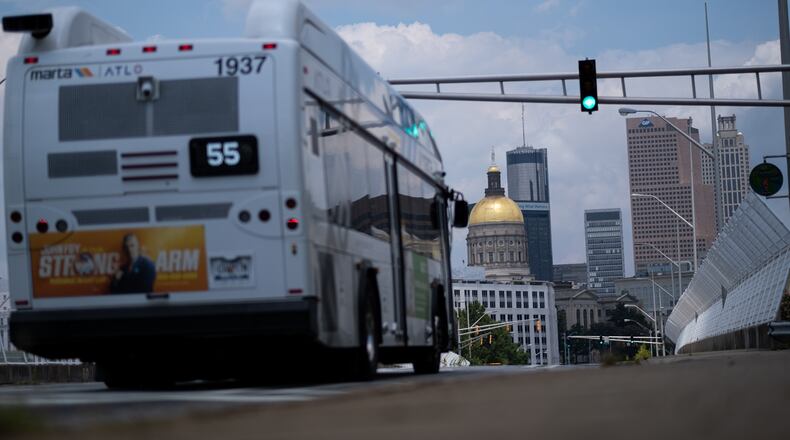The grinding Atlanta commute is nearly as out-of-fashion as cargo pants these days, given the pandemic-driven habits many have assumed. Working from home has lightened the traffic load both in automobiles and on MARTA trains and buses. And the lack of delays on the roads has made the need for MARTA less for those who don’t work from home, but have vehicles. A consistent reliable trip time to work or home is often possible behind the wheel these days (in morning drive, anyway).
But MARTA is still up and running for those without vehicles, catching flights, and not working at home. But the system is seeing far less ridership on all platforms than before, as it joins many slow businesses in just riding out this seemingly interminable pandemic pattern.
All that said, MARTA is still planning for future expansion.
The agency is laying the groundwork for bus rapid transit. Bus rapid transit costs roughly 10% of the nine-digit dollar-per-mile price tag of expanding heavy rail. BRT involves dedicated lanes for buses that have very few stops. So the buses work like trains without rails, with far less impact felt from traffic flow than a trip in a regular automobile.
AJC transportation reporter David Wickert has laid out Metro Atlanta’s BRT plans very well. The Atlanta Regional Commission has earmarked $11 billion dollars for transit expansion, which includes BRT routes in Clayton County, routes linking Center Parc Stadium (GSU Stadium’s new name) to both MARTA rail and the BeltLine, and even a BRT route between Kennesaw State University and the Arts Center. The City of Atlanta has BRT lines funded and on the board for Capitol Avenue to Summerhill, along Northside Drive and Metropolitan Parkway from I-75 to Lakewood, and along the North Avenue/Hollowell Parkway corridor between the Old Fourth Ward and west Atlanta. Construction begins on the Capitol Ave. line, which connects Downtown Atlanta to a south portion of the BeltLine, in 2022 and isn’t scheduled to open until 2024.
To give an idea of what the Capitol line and possibly others would look like, the route, which follows current bus route 55, would have 12 station areas (with stations sometimes on both sides of the street). Buses on the new line would arrive every 10-15 minutes, versus the current 20-30 minute intervals on the current 55 route. And the buses would largely travel in their own lanes, with little interruption from surrounding cars.
Bus rapid transit could also proliferate in Gwinnett County, but the funding measure is in voters’ hands. The November ballot measure calls for a 30-year, 1% sales tax. While MARTA’s heavy rail extension from Doraville to Jimmy Carter will account for 17% of the forecast $12.1 billion collected over the life of the proposed tax, much of the plan calls for bus expansion, including bus-rapid-transit routes. And a large part of Gwinnett’s transit will operate outside of the MARTA umbrella.
“Gwinnett and MARTA are in the very early stages of discussions about what the relationship will look like,” MARTA spokesperson Stephany Fisher told the AJC. “But we have other examples that we can look to, such as when Bay Area Rapid Transit (BART) was extended beyond their district (San Francisco) to San Jose.”
This revamped initiative in Gwinnett follows the failed March 2019 attempt at funding on a special election ballot.
All of this talk about mass transit may seem moot in today’s conditions. Nearly overnight, Atlanta traffic went from awful to tolerable this spring. And even if some temporary habits, such as working from home, become permanent, there are still plenty of cars on the roads, and traffic issues still cause sizable delays. Also, Atlanta’s population is expected to continue growing, and that reality is for what transportation officials plan.
Fisher said MARTA has remained important during the shutdown: “While post-COVID travel behavior remains uncertain, the last five months have highlighted the importance of public transit in getting people to essential jobs and essential destinations.”
MARTA and other transit agencies’ abilities to expand, innovate, and plan for the future are essential in keeping pace with Metro Atlanta’s growth. Building the correct, smart roadway expansions is also key in this success. And the transition to working from home is also easing the pain of gridlock. Strange as it may be, Gwinnett voters hopefully will consider the future need for bus rapid transit and other mass transit needs when the present doesn’t demand them.
Doug Turnbull, the PM drive Skycopter anchor for Triple Team Traffic on 95.5 WSB, is the Gridlock Guy. He also writes a traffic blog and hosts a podcast with Smilin’ Mark McKay on wsbradio.com. Contact him at Doug.Turnbull@cmg.com.
About the Author
The Latest
Featured


